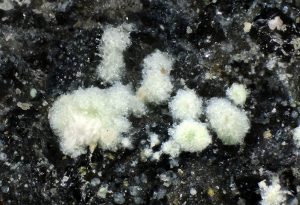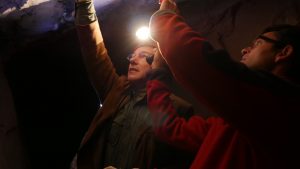Carbon Mineral Challenge Update Spring 2016: Four New Minerals Found
28 April 2016In December 2015, when researchers boldly predicted that 145 carbon minerals remained undiscovered on Earth, they understood the challenges of finding them. As small as a grain of sand, as ephemeral as a volcanic eruption before a rainstorm, missing carbon minerals are often elusive. Hence the impetus behind the Carbon Mineral Challenge.

Common kestrel (Falco tinnunculus). Credit Andreas Trept
Such is the case of tinnunculite, one of four newly described carbon minerals. Tinnunculite only exists when the excrement of a falcon bakes in the hot gases of a coal fire. To add to the obscurity of the new species, a rule by the International Mineralogical Association (IMA), mineralogy’s governing body, stipulates that all minerals must form under natural conditions. This particular mineral has gone through several rounds of submission and rejection, but as of early 2016 tinniculite is officially a mineral.
Abellaite, another new mineral, is a hydrous carbonate that has defied discovery possibly due to its lack of color and odd structure. Of the other new carbon minerals, abellaite stands out as a mineral species predicted in Hazen et al’s recent paper on carbon mineral diversity [1]. It was predicted to exist based on analogy to a synthetic material that had not yet been found in nature. Now that a natural example has been found, it can be named as a mineral according to rules set forth by the IMA.
Meet the new minerals
Abellaite [NaPb2(CO3)2(OH)]

Abellaite. Credit Matteo Chinellato.
This mineral was predicted in Hazen et al (2015), and was found by amateur mineral collector Joan Abella i Creus in the abandoned Eureka uranium mine, Catalonia, Spain. Sixty-one known mineral species exist in this mine, eleven of which contain carbon. Abellaite is the only type locality mineral from the Eureka mine, meaning that the material used to define this mineral came from this location. Identifying this mineral was collaborative; Joan Viñals and Xavier Llovet from the University of Barcelona in Barcelona, Spain, obtained scanning electron microscope (SEM) images and elemental data, Jordi Ibáñez-Insa and Josep Elvira from the Institute of Earth Sciences Jaume Almera in Barcelona, Spain, performed X-ray Diffraction analyses, Raman spectroscopy, and optical property measurements, and worked with Núria Oriols, from the National Museum of Art of Catalonia, Spain, to collect Fourier transform infrared (FTIR) spectra [2]. Coincidentally, Orials is currently performing FTIR analyses on Romanesque paintings just a few kilometers from the Eureka mine.

Amateur mineral collector Joan Abella (left), and Jordi Ibanez inside the Eureka mine where abellaite was discovered. The mineral was named in honor of Abella.
Abellaite is a hydrous carbonate, a type of mineral potentially overlooked in the past as they are often colorless or poorly crystallized. Indeed, many of the undiscovered carbon minerals may be hydrous carbonates.
Tinnunculite [C5H4N4O3·2H2O]
This mineral was discovered by Igor V. Pekov, Inna S. Lykova, Vasiliy O. Yapaskurt, Natalia V. Zubkova (Lomonosov Moscow State University, Russia), Nikita V. Chukanov (Institute of Problems of Chemical Physics, Moscow, Russia), Dmitry I. Belakovskiy (Russian Academy of Sciences, Moscow, Russia), Elena P. Shcherbakova (Institute of Mineralogy, Russian Academy of Sciences, Miass, Russia), and Sergey N. Britvin (Institute of Earth Sciences, St. Petersburg State University, Russia) on Mt Rasvumchorr, Kola peninsula, Russia. This mineral was not specifically predicted in the Hazen et al (2015) paper, but was found near Kukisvumchorr Mountain, a location predicted to harbor undiscovered carbon minerals. Mineralogists have described 91 minerals on Mt Rasvumchorr, but only 6 of the known minerals contain carbon. This mineral is an example of a rare mineral species that only exists under very specific conditions. In this case, tinnunculite forms when hot gases from a burning coal dump react with excrement from the European Falcon (Falco tinnunculus). This makes tinnunculite a very rare and fragile mineral species. The mineral was named in honor of the species of falcon whose excrement is needed to crystallize it [3].
Marklite [Cu5(CO3)2(OH)6·6H2O]
Prof. Gregor Markl (University of Tübingen, Germany) discovered this mineral in the dumps of the Friedrich-Christian mine, Baden-Würtenberg, Germany. It was characterized by Jakub Plášil (Institute of Physics, Academy of Sciences of the Czech Republic, Prague, Czech Republic), Anthony R. Kampf (Natural History Museum of Los Angeles County, Los Angeles, USA), Melanie Keuper (University of Tuebingen, Tübingen, Germany), and Radek Škoda (Masaryk University, Brno, Czech Republic) [4]. Like tinnunculite, marklite was discovered very near a predicted carbon mineral-bearing location, Clara Mine, Baden-Würtenberg, Germany. Seventy-two minerals exist at the Friedrich-Christian mine, thirteen of which contain carbon. Marklite has a very similar chemical composition to the known carbon minerals malachite and azurite, whose strong green and blue colors make them valuable to mineral collectors and jewelry makers.
Middlebackite [Cu2C2O4(OH)2]
This mineral was discovered in the Iron Monarch quarry, in the Middleback Ridge, Australia by the quarry manager. It was identified by Peter Elliott from the University of Adelaide, Australia, and named for the Middleback Range. A whopping 163 minerals exist here, and 17 of these are carbonate minerals. The middlebackite type material was discovered in June 1990 but it wasn’t characterized as a new mineral species for 25 years. The more recently developed technique of single-crystal X-ray diffraction using synchrotron radiation helped mineralogist Peter Elliott determine the structure of this new carbon mineral [5].
Four months into the Carbon Mineral Challenge, we have already verified one carbon mineral with a predicted chemistry, two carbon minerals coming from locations thought to harbor great carbon mineral diversity, and one newly analyzed carbon mineral previously sitting unknown in a collection. It is exciting to confirm some of the predictions made by Robert Hazen, Daniel Hummer, and their team of researchers, and even more exciting to anticipate all of the carbon minerals that are still awaiting discovery by 2019.
To see the entire list of known carbon minerals, visit this page.
References:
- Hazen RM, Hummer DR, Hystad G, Downs RT, Golden JJ (2015) Carbon mineral ecology: Predicting the undiscovered minerals of carbon. American Mineralogist 101:889-908
- Ibáñez-Insa J, Elvira JJ, Oriols N, Llovet X, Viñals J (2016) Abellaite, IMA 2014-111. CNMNC Newsletter No. 29, February 2016, page 200; Mineralogical Magazine, 80, 199-205.
- Pekov IV, Chukanov NV, Belakovskiy DI, Lykova IS, Yapaskurt VO, Zubkova NV, Shcherbakova EP, Britvin SN (2016) Tinnunculite, IMA 2015-021a. CNMNC Newsletter No. 29, February 2016, page 202; Mineralogical Magazine, 80, 199-205.
- Plášil J, Kampf AR, Keuper M, Škoda R (2016) Marklite, IMA 2015-101. CNMNC Newsletter NO. 29, February 2016, page 202; Mineralogical Magazine, 80, 199-205.
- Elliott P (2016) Middlebackite, IMA 2015-115. CNMNC Newsletter No. 30, April 2016; Mineralogical Magazine 80.

